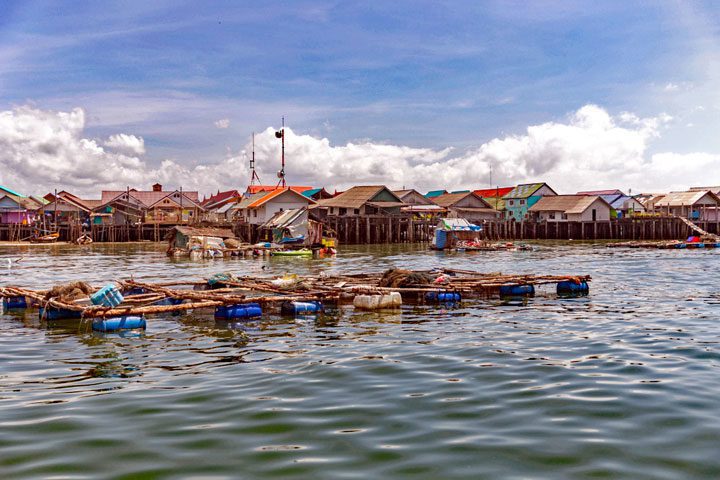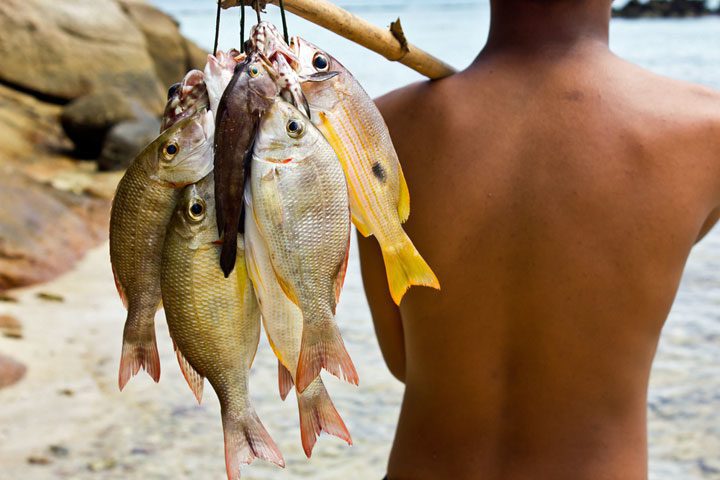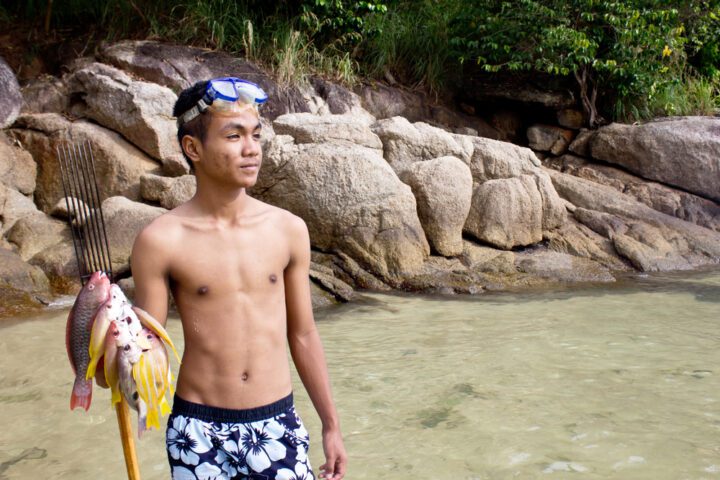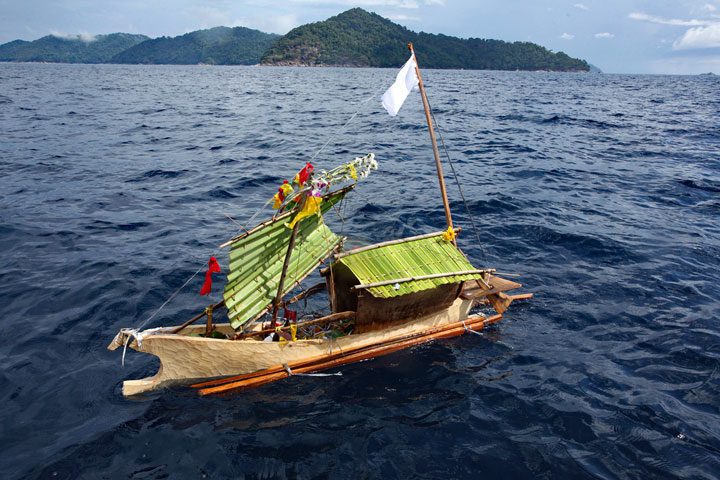Seagipsys in Thailand

mariakraynova / Shutterstock.com
Thailand has a number of ethnic minorities, of which the hill tribes in the North are fairly well known. In the south, seagipsy's are a somewhat neglected minority.
I say “seagipsy's” on purpose, because it sounds kinder to me than the translation sea gypsies. Thailand has three main groups of seagipsy's: the Moken, the Urak Lawai and the Mokler. To the Thais, these people are known as "Chao Lay" (sea people), an umbrella term for the tribes that live off the sea and whose lineage is closely linked to the sea.
Mugs
There is a group of about 2.000 to 3.000 people who live off the coast of Thailand, Myanmar and Malaysia around the Surin Islands (a national park). They are known as the Moken, speak a language of their own, from which experts have not been able to determine where the Moken originally come from. They are believed to have been the first inhabitants of the coastal areas in the Andaman Sea. Their nomadic marine culture probably brought them from southern China to Malaysia over 4.000 years ago, where groups eventually split off in the late 17th century, but the exact history of their existence is not known.
The Moken live around and at sea and of course they are excellent fishermen; they know the sea around them like no other. If a man wants fish for breakfast, he goes into the sea with a spear and in no time he has caught a meal of fish. Research shows that the Moken can see twice as well under water compared to, for example, Europeans. They have also been shown to be able to dive as deep as 25 meters without diving gear.
The biggest threat to their culture is that private investors and land speculators want to further develop the areas where the Moken live. For the time being, that "attack" has been averted and they can continue their lives carefree. Worrying isn't a Moken trait anyway, it's not in their vocabulary.

How well the Moken know the whims and whims of the sea is reflected on December 26, 2004. A number of elderly people from the Moken tribe on an island in the Surin Islands Marine National Park off the coast of Phang-Nga province notice that the waves at sea are abnormal and that movements occur in an unusual way. They raise the alarm and the inhabitants take refuge in the higher interior. When they return, the village has been completely wiped out by La Boon – as the Moken call the tsunami – which has devastated the area.
Their boats and houses on stilts are nothing more than a heap of wood and rubble. But while Thailand mourns more than 5.000 victims, the Moken community has been spared, thanks to the elder tribesmen's knowledge of the sea.
The Moken have rebuilt their village, using bamboo and leaves as the main "building blocks". Not in the same place, but more inland where it is safer. If the Moken have one concern, it is that they miss their traditional environment around the sea from their new village. The influence of the outside world is increasing. Thai authorities have banned the fishing of certain species of fish, such as the sea cucumber and some shellfish, depriving the Moken of an important source of income. Some of them have already left the fishing village to work as diving guides for tourists or to become garbage collectors.
The Moken have a very social life. There are different tribes, but everyone is equal. A tribe member can thus move from one tribe to another without his life being made miserable. They therefore do not say goodbye, because words such as “hello” and “goodbye” do not occur in their language. The word “when” is also unknown, because the Moken have no concept of time other than day and night – so they don't know how to hurry.
An interesting fact is that harpooning a turtle comes close to taking a wife. The sea turtle is considered sacred by the Moken and the Moken probably see a woman as a saint as well.

In terms of religion, the Moken believe in animism – the doctrine of the spirit beings. In societies that live off nature and hunting, man is often equated with nature and is therefore not above it. Respect for nature and everything around it is essential, rituals are vital for survival. With this they win the favor of the spirits, who provide food, shelter and fertility and at the same time repel evil spirits.
Mokler
The Mokler are a group of seagipsy's or "Chao Lay" who receive the least amount of attention from media and public. This is because their villages are located in areas where little or no tourists come. The Urak Lawoi and the Moken are mentioned again and again, because they live in or near popular tourist destinations such as Phuket, Lanta and Lipeh islands (the Urak Lawai) and the Surin islands (the Moken).
The Mokler are considered a sub-group of the "Chao Lay" or "Thai Mai" (New Thais), who live regular lives and have also acquired Thai citizenship. Mokler's children attend a local school and receive education in the Thai language. Most of them do not speak the Mokler language, although they understand it when they talk to their parents or grandparents.
Most of the Mokler villages can be found in Phang-Nga province on the west coast of Thailand. They are scattered in Khuraburi, Takuapa and Thaimuang district. Many Mokler are in fact already landlubbers, as their villages are not in the coastal areas but inland. Often they consider themselves traditionally agricultural; they work on a rubber or coconut plantation or are hired as laborers for various other tasks. There are still a few coastal villages, where the sea is still a source of income for the Mokler.
Although many Mokler consider Buddhism to be their religion, their animistic beliefs are still very important. Every year in February/March, the Mokler celebrate a sacrificial feast for their legendary leader Ta Pho Sam Phan.

Urak Lawoi
This group of seagipsy lives around the islands and coastal areas of the Andaman Sea. Their villages can be found in Phang-nga, Phuket, Krabi and Satun.
The Urak Lawoi also have their own language and traditions. In general, Urak Lawoi are called Chao Lay, Chao Nam or Thai Mai. They themselves find Chao Nam a derogatory term, because “Nam” also means semen in their language. They prefer Thai Mai, with which they want to express themselves as an integral part of the Thai state.
There is a legend about the Urak Lawoi on Adang Island. Long, long ago, God sent Nabeeno to the island to encourage the inhabitants to worship God. The Urak Lawoi ancestors refused, after which God placed a curse on them. The Urak Lawoi then left for Gunung Jerai, where some flee into the forest and turn into savages, monkeys and squirrels. Others went out to sea as nomads in a boat called Jukok. Gunung Jerai remains a sacred place for the Urak Lawoi and twice a year a ceremony is held, at the end of which decorated boat is launched, which – Urak Lawoi assume – heads for the original settlement near Gunung Jerai.
The Urak Lawoi form only a small community, which is largely related to each other. They usually live in small bamboo houses built on stilts, the front of which always faces the sea. The houses are usually built with the support of family and neighbors.
The daily life of the Urak Lawoi is simple. In the morning the men go fishing, while the women do the housework and wait for their husbands to return around noon. The caught fish is for the use of one's own family and/or relatives, while another part of it is sold to traders. In the afternoon the women rest while the men put their fishing gear back in order.
Life does change, because with fishing they hardly reach a subsistence level, so that many men work elsewhere to earn a decent wage.
Besides seafood, rice is the main food for the Urak Lawoi. They eat various Southern Thai dishes, in which the coconut is an essential ingredient. The Urak Lawoi usually eat when they are hungry, so there is no set meal at a certain time.
Long ago, the Urak Lawoi believed that evil spirits were the cause of illness. They had a local doctor (to ie), who fought the disease by incantation or the use of holy water. A "maw" is a personal medium that communicates between the Urak Lawoi and the spirits. The “maw” is chosen from an elder of the tribe, who also teaches the children in traditional spiritual healing. Today they do use doctors and hospitals.
The way of life of the Urak Lawoi is gradually integrating into Thai culture. They can no longer make it independently and are therefore increasingly dependent on others (Thai) for work and income.


Here's another good story about these people:
https://aeon.co/essays/do-thailand-s-sea-gypsies-need-saving-from-our-way-of-life
"In the south, seagipsys are a somewhat neglected minority," you say.
They have been seriously neglected. Their land is being taken away by companies who want to build resorts etc. there. That led to riots. See:
https://www.hrw.org/news/2016/02/13/thailand-investigate-attack-sea-gypsies
The story first appeared on the blog in 2012.
A lot has happened to the seagipsy's in a negative sense, so that
“a somewhat neglected minority” has now become an understatement.
It is clear that they are severely neglected and prey to
project developers and other scum that are literally and figuratively about corpses.
Very interesting article!! The world sure is hard when it comes to money!!!
Some additional information from the Urak – Lawoi on Koh Lipe
Me and my wife have spent many years (since 1997) on this beautiful island.
https://www.researchgate.net/profile/Supin-Wongbusarakum/publication/281584589_Urak_Lawoi_of_the_Adang_Archipelago/links/5d30ce1d458515c11c3c4bb4/Urak-Lawoi-of-the-Adang-Archipelago.pdf?origin=publication_detail
Thank you very much for this detailed explanation about the seagipsy's and have been there years ago. On the island of Koh Lanta. Spent a day there and invited to go fishing and afterwards listen to their music of which I still have a CD.
Interesting to read about it again after many years. I had read about it a long time ago and then, after much wandering, finally found a book about the Moken. I don't remember where I finally found it, but there wasn't much information about it at the time, so it's good that attention is being paid to a very special and interesting society.
These are the definitive books about the Moken, incl. folktales, their status and life today, their boats, their way of life:
https://www.whitelotusbooks.com/books/rings-of-coral-moken-folktales
https://www.whitelotusbooks.com/books/moken-sea-gypsies-of-the-andaman-sea-post-war-chronicles
https://www.whitelotusbooks.com/books/moken-boat-symbolic-technology-the
https://www.whitelotusbooks.com/books/journey-through-the-mergui-archipelago-a
This research was carried out by Jacques Ivanoff and his father.
There are also works in the French language about the Moken.
I once read and translated Sea-gypsies of Malaya, a reprint of the 1922 book of the same name. ISBN 9789748496924. I bought it from DCO. English language. About the Moken.
Gringo, in my book I find the word ชาวเล , chaw-lee in Dutch pronunciation. Lee is very similar to tha-lee which means 'sea'. Furthermore, I find gypsy-gypsy-gypsy's and gypsies and I wonder what the correct spelling is… Van Dale says both gypsy and gypsy.
For lovers, music from the Moken. (Beware, the sound comes max…)
https://archive.org/details/Moken